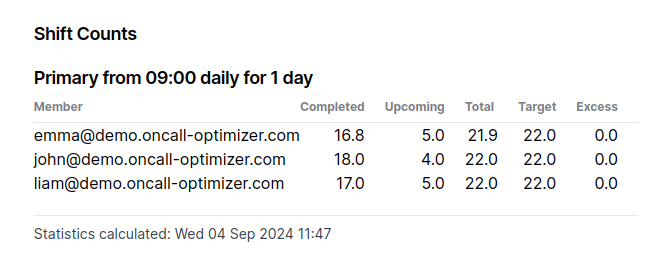Schedule Balance
The balance of shifts between members of a schedule is one of the primary objectives that On-Call Optimizer targets.
On-Call Optimizer considers a schedule to be balanced when each member has a share of the total number of shifts that is proportional to the time at which they were added to the schedule.
This means that the target number of shifts for each member in the schedule will often differ - members who joined the schedule around the same time will have similar targets, but the target will vary between members who have joined the schedule at a later date.
Statistics describing the balance of the schedule are available for the current assignment - showing the live state of the schedule, and can also be viewed when creating new custom assignments or examining the history of a particular assignment - showing a snapshot view of how that assignment altered, or will alter the balance of the schedule when it is or was confirmed.
Summary

At the top of each assignment page you will find a summary line containing details on the balance of the schedule and the quality of the assignment. The following icons and colours are used to provide a quick visual overview of the status of the schedule balance:
Live Balance

The live balance of a schedule will be displayed when viewing the current assignment for a schedule using a table similar to the one shown here. For each member the following information is shown:
Completed- the number of shifts already completed by the member (any shift currently in progress is counted as completed in this table).Upcoming- the number of shifts that have been confirmed for the member in future assignments.Total- the total number of completed and upcoming shifts assigned to the member.Target- the number of shifts that the member should be assigned, based on the the number of assignable members in the schedule and when they joined.Excess- the number of shifts that the member’s total is in excess of their target.
Assignment Snapshot Balance
The impact of an individual assignment on the balance of a schedule can be seen on the assignment details page both before the assignment is confirmed and afterwards.
The balance table shown for an individual assignment is very similar to the example for the live balance above, except that the the Completed and Upcoming columns
are replaced with Previous and New columns instead:
Previous- the number of shifts already assigned to the member (may be completed or upcoming) which are not changing in the assignment.New- the number of additional shifts that will be assigned to the member when the assignment is confirmed.Total- the total number of previous and new shifts that will be assigned to the member when the assignment is confirmed.Target- the number of shifts that the member should be assigned at the time when the assignment is confirmed.Excess- the number of shifts that the member’s total is in excess of their target.
Unlike the live balance shown for the current assignment, the balance statistics shown for an individual assignment are a snapshot of the balance of the schedule at the point in time when the assignment was generated or confirmed.
Shift Types
The balance for a schedule is calculated and tracked individually for each type of shift in the schedule. Shift types follow directly from the Shift Configuration of the schedule and are described by the day and time at which the shift starts, combined with its duration. The role (primary, secondary, etc) assigned forms the final component of a shift type, to ensure members are assigned a proportionate number of shifts for each role.
Shift accounting
The numbers reported in the balance tables count the number of shifts of each type assigned to a member and will therefore represent different lengths of time. In the balance table for a daily shift, a value of 1.0 would represent 24 hours, while in the table for a weekly shift a value of 1.0 would represent 168 hours.
Fractional shift numbers will arise in a number of situations, commonly including:
- When the total number of shifts in the schedule is not evenly divisible by the number of members.
- When swaps or other changes have resulted in the member only performing part of a shift.
Window Size
The balance for a schedule is calculated from the earliest shift contained within the history window (6 months in the past) until the final future shift that has been assigned.
Even when displayed in the context of an individual assignment that may only be covering a few days of time, the balance reported is for the schedule over the entire window.
Feedback
Was this page helpful?
Glad to hear it! Please tell us how we can improve.
Sorry to hear that. Please tell us how we can improve.